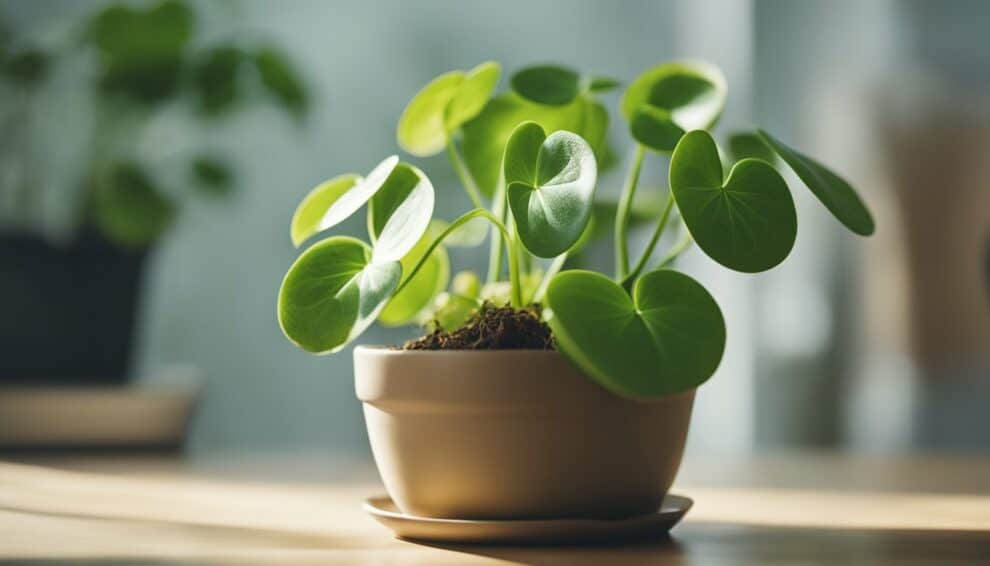The Chinese Money Plant, also known as Pilea Peperomioides, has become a popular houseplant due to its unique circular leaves and ease of care.
Originally from China, this plant has made its way into homes all over the world.
However, despite its popularity, many people may not know how to properly care for their Chinese Money Plant.

To keep your Pilea Peperomioides healthy and thriving, it is important to understand its specific care requirements.
This article will provide expert tips on how to care for your Chinese Money Plant, including information on watering, lighting, soil, and propagation.
Whether you are a seasoned plant parent or a beginner, these tips will help you successfully care for your Pilea Peperomioides.
Understanding the Pilea Peperomioides
Origins and Characteristics
Pilea Peperomioides, also known as the Chinese money plant, is a popular houseplant that belongs to the nettle family.
It is native to the Yunnan Province in Southern China, where it grows in the understory of forests.
The plant was first introduced to the Western world in the early 1900s and has since become a favorite among plant enthusiasts.
The Pilea Peperomioides is a small, herbaceous plant that grows up to 12 inches tall.
It has a unique appearance, with round, coin-shaped leaves that grow on long, thin stems. The leaves are bright green and have a slightly shiny, waxy texture.
The plant also produces small, white, star-shaped flowers that bloom in the summer.
Common Names
The Pilea Peperomioides is commonly known as the Chinese money plant, UFO plant, pancake plant, and missionary plant.
The name “Chinese money plant” comes from the belief that the plant brings good luck and prosperity to its owner.
The name “UFO plant” is a reference to the shape of the leaves, which resemble flying saucers.
The name “pancake plant” refers to the flat, round shape of the leaves, which resemble pancakes.
The name “missionary plant” comes from the story of a Norwegian missionary who brought the plant back to Europe from China in the 1940s.
Overall, the Pilea Peperomioides is a unique and interesting plant that is easy to care for and makes a great addition to any home.
Essential Care Guidelines

When it comes to taking care of a Chinese Money Plant (Pilea Peperomioides), there are a few essential guidelines to follow.
These guidelines include lighting requirements, watering techniques, soil and repotting, and temperature and humidity.
Lighting Requirements
The Chinese Money Plant requires bright, indirect light.
Direct sunlight can scorch the leaves, while too little light can cause the plant to become leggy and weak.
It is recommended to place the plant near a north or east-facing window, or to provide artificial lighting if natural light is not sufficient.
Watering Techniques
Overwatering is one of the most common mistakes made when caring for a Chinese Money Plant.
The plant prefers to be kept on the drier side, and it is important to allow the soil to dry out between waterings.
When watering, it is best to water from the bottom up, allowing the plant to soak up water through the drainage holes in the pot.
This helps to prevent water from sitting in the soil, which can lead to root rot.
Soil and Repotting
The Chinese Money Plant prefers well-draining soil, such as a mixture of potting soil and perlite or sand.
Repotting should be done every 1-2 years, or when the plant has outgrown its current pot.
When repotting, it is important to use a pot that is only slightly larger than the current one, as the plant prefers to be slightly root-bound.
Temperature and Humidity
The Chinese Money Plant prefers temperatures between 60-75°F (15-24°C), and humidity levels around 50%.
It is important to avoid placing the plant near drafts or heating/cooling vents, as this can cause stress to the plant.
If the air in your home is particularly dry, it may be helpful to place a small humidifier near the plant to increase humidity levels.
By following these essential care guidelines, you can help your Chinese Money Plant thrive and grow into a beautiful, healthy plant.
Growth and Maintenance

Fertilizing Schedule
Pilea peperomioides, commonly known as the Chinese money plant, is a fast-growing plant that requires regular fertilization to maintain its health and vigor.
Fertilizers provide the necessary nutrients that the plant needs to grow, produce healthy leaves and flowers, and resist diseases.
To fertilize a Chinese money plant, it is recommended to use a balanced, water-soluble fertilizer with an NPK ratio of 20-20-20 or 10-10-10.
The fertilizer should be diluted to half-strength, and applied once a month during the growing season (spring and summer).
During the dormant season (fall and winter), fertilization should be reduced or stopped altogether.
Over-fertilization can cause the plant to grow too quickly and become leggy, or even burn the roots and leaves.
Therefore, it is important to follow the recommended fertilizing schedule and dosage, and to avoid applying fertilizer on dry soil or on leaves.
Pruning and Propagation
Pruning and propagation are important aspects of Chinese money plant care, as they help to shape the plant, promote new growth, and produce new plants.
Pruning can be done throughout the year, but it is best to do it in the spring or summer, when the plant is actively growing.
The purpose of pruning is to remove dead, damaged, or yellowing leaves, as well as to control the size and shape of the plant.
To prune a Chinese money plant, simply use a sharp, clean pair of scissors or pruning shears, and make a clean cut just above a leaf node.
Propagation is the process of creating new plants from existing ones, and it can be done through stem cuttings or division.
Stem cuttings are the most common method of propagation, and they involve taking a healthy stem with a few leaves, and rooting it in water or soil.
Division is another method, and it involves separating the plant into two or more parts, each with its own roots and leaves.
In conclusion, proper growth and maintenance of a Chinese money plant require regular fertilization, pruning, and propagation.
By following these expert tips, you can ensure that your plant stays healthy, beautiful, and productive for years to come.
Troubleshooting Common Issues

Pest Infestations
Chinese Money Plants are generally resistant to pests, but infestations can occur.
The most common pests that affect Pilea Peperomioides are spider mites, mealybugs, and scale insects.
Spider mites are tiny and difficult to spot, but they can be identified by the fine webbing they leave behind.
Mealybugs appear as white, cottony masses on the leaves and stems, while scale insects look like small bumps on the plant.
To prevent pest infestations, it is important to regularly inspect your plants and remove any pests as soon as they are detected.
You can also use insecticidal soap or neem oil to control infestations.
Be sure to follow the instructions on the product label and avoid using harsh chemicals that can damage the plant.
Disease Prevention
Chinese Money Plants are generally healthy and disease-resistant, but they can be susceptible to root rot if overwatered.
To prevent root rot, make sure the soil is well-draining and allow the top inch of soil to dry out before watering again.
It is also important to avoid getting water on the leaves, as this can lead to fungal diseases.
To prevent the spread of disease, it is important to regularly clean your pruning tools with rubbing alcohol and avoid touching healthy plants after handling infected ones.
If you notice any signs of disease, such as yellowing or wilting leaves, remove the affected parts of the plant and treat with a fungicide if necessary.
Leaf Discoloration and Drop
Chinese Money Plants can experience leaf discoloration and drop for a variety of reasons, including overwatering, underwatering, poor lighting, and nutrient deficiencies.
If your plant is experiencing these issues, it is important to identify the underlying cause and address it accordingly.
To prevent leaf discoloration and drop, make sure your plant is getting the right amount of water and light.
Avoid placing your plant in direct sunlight, as this can cause the leaves to burn.
If you suspect a nutrient deficiency, consider fertilizing your plant with a balanced fertilizer.
By following these tips, you can keep your Chinese Money Plant healthy and thriving.
Frequently Asked Questions

How often should I water my Chinese Money Plant?
The Chinese Money Plant prefers moist soil, but it is important not to overwater it.
It is recommended to water your Pilea Peperomioides once a week during the growing season, and once every two weeks during the winter months.
Be sure to let the soil dry out slightly before watering again.
What are the ideal lighting conditions for a Pilea Peperomioides?
The Chinese Money Plant thrives in bright, indirect light.
Direct sunlight can scorch the leaves, so it is best to place your Pilea in a location with filtered or indirect light.
If you notice your plant leaning towards the light source, it may be an indication that it needs more light.
Can you give tips on propagating a Chinese Money Plant?
Propagation of the Chinese Money Plant is relatively easy. The most common method is to take stem cuttings and root them in water or soil.
It is important to make sure the cutting has at least one leaf node and to keep the soil moist but not waterlogged.
It may take a few weeks for the cutting to root, but once it does, it will begin to grow new leaves.
What type of soil is best for a healthy Pilea Peperomioides?
The Chinese Money Plant prefers well-draining soil that is rich in organic matter.
A mixture of potting soil and perlite or sand can help ensure good drainage.
It is important to avoid using heavy, clay-based soils that can retain too much moisture.
How do I know if my Chinese Money Plant is getting too much light?
If your Chinese Money Plant is getting too much light, the leaves may begin to curl or turn brown around the edges.
You may also notice the plant becoming more compact and bushy.
If you notice these signs, it is best to move your Pilea to a location with less direct light.
What should I do if the leaves of my Pilea start to droop?
If the leaves of your Chinese Money Plant start to droop, it may be an indication that it needs more water.
Be sure to check the soil moisture level and water accordingly. If the soil is too dry, the leaves may also begin to curl or brown.













